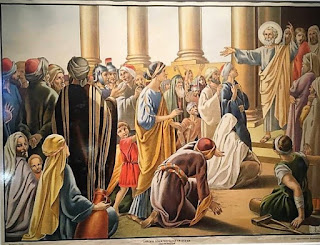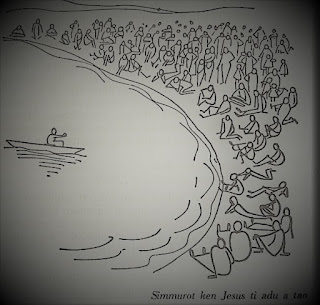 |
Portrait of the Preaching of Peter at Pentecost
(Santa Casa di Misericordia, Macau) |
“We thank you for the vaccines developed made possible by your guiding hands," goes a line from the updated version of the Oratio Imperatio for Protection against Covid-19 Virus.
God's hand (YAD in Hebrew) is often used as a metaphor for divine power (DYNAMIS in Greek). "But you shall receive power [DYNAMIS] when the Holy Spirit comes upon you, and you shall be My witnesses in Jerusalem, in all Judea and Samaria, and to the ends of the earth" (Acts 1:8).
The Acts of the Holy Spirit
If we were to re-title the Acts of the Apostles, it should easily be “Acts of the Holy Spirit.” In this second volume of Luke’s writing (the first volume is the Gospel of Luke), the Holy Spirit acts, inspires, directs, and moves to action the early Christians and their mission.
In Paul’s second missionary journey, he and Silas wanted to bring the Gospel to the East by trying to go to Bithynia (northwestern part of modern-day Turkey), but “they have been prevented by the Holy Spirit from speaking the word in Asia” (16:6).” As Luke narrates, “the Spirit of Jesus did not allow them” (16:7).
Only the Holy Spirit knows why the Gospel should not be preached first to the Far East, but Paul and Silas must not pursue their own personal plans and projects nor depend on their ability and experience. They must go where the Spirit blows. Thus, they went westward, to Troas, and from there they brought the Gospel to Europe (16:11-12).
The Acts of the Apostles mentions the word “spirit” (pneuma or pneo) 115 times; the Gospel of Luke – 50 times; all in all, 164 times.
The book begins with reminiscing of Jesus’ teachings “through the Holy Spirit” (1;2) and ends with again reminiscing of how the Holy Spirit spoke through the prophet Isaiah to the ancestors (28:25).
Likewise, the Gospel of Luke begins the announcement of the birth of John the Baptist who would be “filled with the Holy Spirit” (1:15). With this literary style called inclusio (when a word is mentioned at the beginning and at the end of writing), we can say that Acts of the Apostles and the whole of Luke’s works are “embraced” by the Holy Spirit.
Well, the entire Bible is actually “embraced” by the Spirit.
The Book of Genesis begins with the “spirit of God” hovering over the waters (1:2) and ends with the invitation of the “Spirit and the bride” in the last chapter of the very last writing of the Bible – the Book of Revelation (22:17).
It is no surprise then that in telling us the story of the early Church, Luke begins with the story of the coming of the Holy Spirit to the disciples (2:1-13). This is a landmark event and also a crucial section in the narrative. From this moment onwards, the disciples would no longer be afraid and timid to proclaim publicly the good news of Jesus.
The fire in the Pentecost speech of Peter is noticeably due to the power of the Holy Spirit (2:14-36). The same Holy Spirit would move the disciples to a koinonia, (“fellowship” or common life), listening to the teachings of the Apostles, breaking bread and praying together, selling their properties, and possessions to help each other (see 2:42-47; also 4:32-35).
The Holy Spirit is a prime mover in the Acts of the Apostles, like the “timonero” or the helmsman steering the boat safely to its destination.
The Pentecost and the Coming of the Spirit
What’s the connection between the Coming of the Holy Spirit with the day of Pentecost? Pentecost or the Feast of Weeks (SHAVUOT in Hebrew) is one of the more important feasts in the Old Testament. Described as “feast of harvest, of the first fruits of your labor, of what you sow in the field” (Exodus 23:16) and “the first fruits of wheat harvest” (Exodus 34:22), Pentecost was from the start, a farmers’ feast. It was an occasion to show Israel’s debt of gratitude to YHWH for the first fruits of the early harvest.
In the ancient religion of Canaan, the one responsible for a good harvest is Baal. He is the storm god, the god of rain, the rider of the cloud—these titles are associated with rain and vegetation. More than half of the land of Israel is wilderness or desert, and rain is rare. Anyone who can send rain and a good harvest must be a powerful god. The Israelites occasionally turn to Baal thinking that he is the one who gives “the grain, the wine, and the oil” (Hosea 2:10). Thus, the Feast of Weeks or Pentecost is not only an occasion to thank God for the early harvest; it is also to affirm that the God of Israel, and not Baal, is the only one who can give rain and good harvest (see Psalm 135:7).
By associating the Jewish Pentecost with the Descent of the Holy Spirit, we can say that YHWH who sent rain and provided good harvest in ancient times is the same God who provides a “good harvest” of believers in the early Church through the Holy Spirit. The prayer taken from Psalm 104:30 is fitting here: “Lord, send forth your Spirit and they shall be created; and renew the face of the earth.”
After the destruction of the Second Temple in 70 A.D., the Pentecost ceased to be an agricultural feast. It was replaced by the Feast Giving of the Torah (Law) on Mount Sinai. In Exod 19:1, the Israelites arrived at the wilderness of Sinai “on the third new moon”. This was interpreted to mean that between the Passover meal in Egypt and arrival at Sinai was fifty days (hence, “Pentecost” from the Greek “fiftieth”). It was most probably this meaning that Luke is familiar with when narrating the Coming of the Holy Spirit on the Feast of the Pentecost in Jerusalem.
Why does Luke then set the day of the coming of the Holy Spirit on the anniversary of the Giving of the Torah on Pentecost? We can think of three reasons:
1. The Giving of the Torah in Sinai is fundamental to the life of Israel
With the Law, Israel would know how to “walk with the Lord” to the Land that the Lord had promised them to possess (Deuteronomy 30:16). Likewise, the Coming of the Holy Spirit is fundamental to the life of the early Christians. It will be the Holy Spirit who would direct their life and mission of preaching the Gospel “to the ends of the earth.”
2. The Giving of the Torah signifies the birth of Israel in the wilderness as the people of God.
The Coming of the Holy Spirit signifies the birth of the Church in Jerusalem.
3. The Coming of the Holy Spirit on the Feast of the Giving of the Torah also signifies that the Church now under the guidance of the Holy Spirit is a continuity of God’s covenant with Israel
This close relationship between Torah and the Holy Spirit in Luke will have to be born in mind when we read the next writing of the New Testament after the Acts of the Apostles – the Letter of Paul to Romans where Paul will make a sharp contrast between the Law and the Spirit (see Romans 7:6).



Comments
Post a Comment